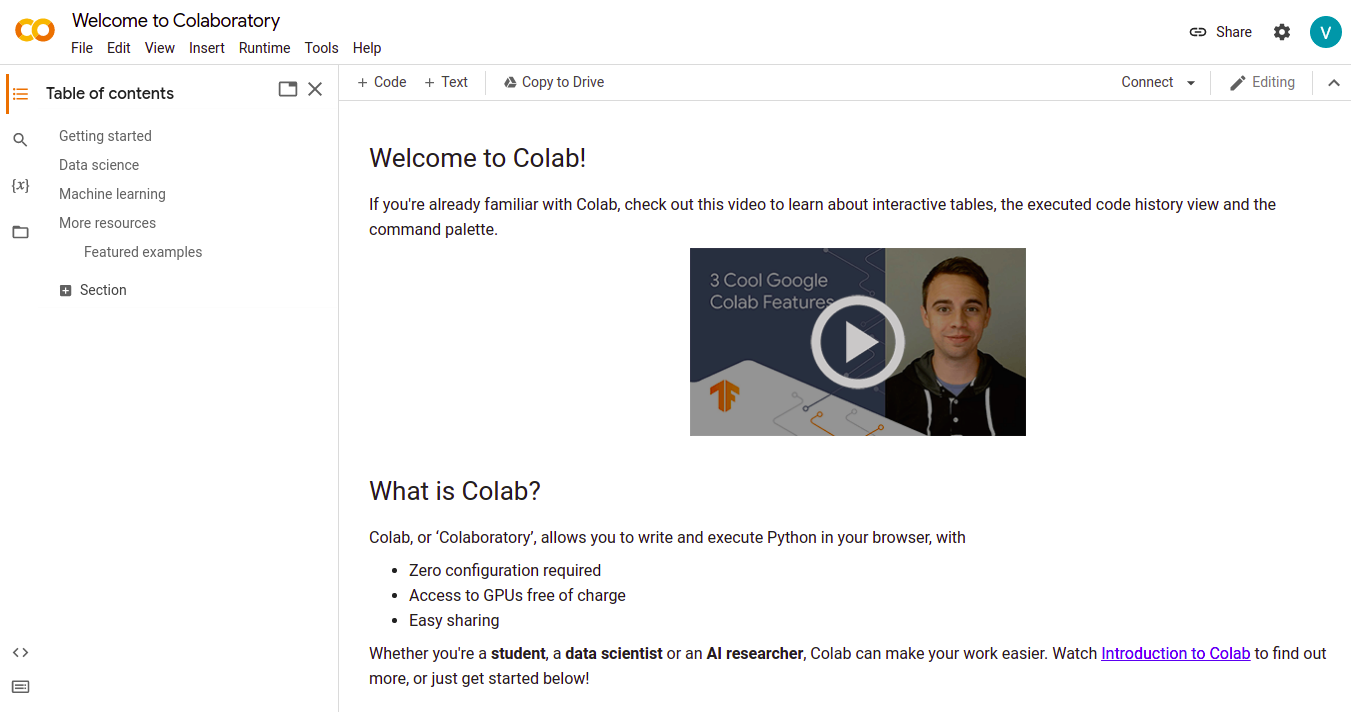Top 15+ Interesting Facts About Google Colab You Might Not Know

Google Colab notebooks allow you to combine executable code and rich text in a single document, along with images, HTML and so on. Just load the Colab interface and start adding your code in executable cells. After work you can save a copy of your full work on Google Drive instance and also on GITHUB.

Google Colab notebook can also be shared across the people just like Docs and Spreadsheet applications on Google Cloud. The Google Colab has a starting free tier that provides a huge amount of memory and processing power for getting started. Once you finish your learning and want to launch something commercial size in production you just need to upgrade you plan to pro level plans.
Here are some of the interesting things about Google Colab curated from all over the internet.
1. What is Google Colab used for?

Colaboratory, or “Colab” for short, is a product from Google Research. Colab allows anybody to write and execute arbitrary python code through the browser, and is especially well suited to machine learning, data analysis and education.
Source: Google Colab
2. Is Jupyter the same as Google Colab?

Google Colaboratory is a freemium tool offered by Google Research that allows users to write and execute Python code in their web browsers. Colab is actually based on the Jupyter open source, and essentially allows you to create and share computation files without having to download or install anything.
Source: Tech Republic
3. How much does Google Colab cost?

For $9.99 per month, pro users get access to faster GPUs like the T4 and P100 if resources are available. Also, runtimes are longer in the pro version and instances are connected for up to 24 hours.
Source: Towards Data Science
4. Is Google Colab using Python?
The Earth Engine Python API can be deployed in a Google Colaboratory notebook. Colab notebooks are Jupyter notebooks that run in the cloud and are highly integrated with Google Drive, making them easy to set up, access, and share.
Source: Google Developers
5. Is Google Colab an IDE?
Google has released Colaboratory: a web IDE for python, to enable Machine Learning with storage on the cloud — this internal tool had a pretty quiet public release in late 2017, and is set to make a huge difference in the world of machine learning, artificial intelligence and data science work.

Google Colab is a free cloud-based service that allows the execution of Python code using the Jupyter Notebook format. It is possible to use and install new python libraries.
6. Which is better: Google Colab or kaggle?
Saving or storing of models is easier on Colab since it allows them to be saved and stored to Google Drive. Also if one is using TensorFlow, using TPUs would be preferred on Google Colab. It is also faster than Kaggle. For a use case demanding more power and longer running processes, Colab is preferred.
Source: Analytics India Mag
7. Is Google Colab good for deep learning?
Google Colab is a great platform for deep learning enthusiasts, and it can also be used to test basic machine learning models, gain experience, and develop an intuition about deep learning aspects such as hyperparameter tuning, preprocessing data, model complexity, overfitting and more.
Source: Neptune AI
8. How much RAM does Google Colab have?
Colab is 100% free, and so naturally it has some resource constraints. As you can see in the screenshot below, each instance of Colab comes with 12 GB of RAM (actually 12.7 GB, but 0.8 GB are already taken). That’s plenty, especially considering that you don’t need to pay for it.
Source: Towards Data Science
9. What are the limitations of Google Colab?
Limited Space & Time: The Google Colab platform stores files in Google Drive with a free space of 15GB; however, working on bigger datasets requires more space, making it difficult to execute. This, in turn, can hold most of the complex functions to execute.
Source: Analytics India Mag
10. Can I run a Python script on Colab?

The Google Colaboratory (“Colab”) is a notebook (like a Jupyter Notebook) where you can run Python code in your Google Drive. You can write text, write code, run that code, and see the output – all in line in the same notebook.
Source: Free Code Camp
11. Which is faster, GPU or TPU?
GPUs have the ability to break complex problems into thousands or millions of separate tasks and work them out all at once, while TPUs were designed specifically for neural network loads and have the ability to work quicker than GPUs while also using fewer resources.
Source: inmotionhosting.com
12. Does colab provide GPU?
Google provides the use of a free GPU for your Colab notebooks.
13. Is a Jupyter notebook an IDE?
Jupyter notebook is an open-source IDE that is used to create Jupyter documents that can be created and shared with live codes.
14. Which GPU is used in Google Colab?
Using the Google Colab environment, we have free access to the “NVIDIA Tesla K80” GPU. But keep in mind that you are limited to using it for 12 hours continuously, after that you may not be able to access it for a particular duration of time unless you purchase Colab pro.
Source: Analytics Vidhya.com
15. Does Google Colab run when the computer is off?
With the browser closed, a Colabs instance will run for at most 12 hours 90 minutes before your runtime is considered idle and is recycled.
Source: StackOverflow
16. Is TPU free?
TPUs were only available on Google cloud but now they are available for free in Colab. https://colab.research.google.com
There is much more on Google Colab, we will see about it later in another article. Till, then share these amazing things about Google’s Colab for developers.





